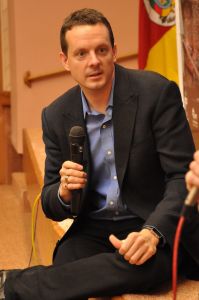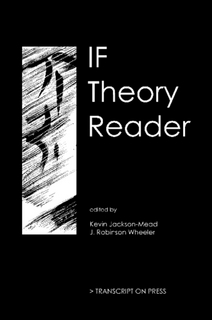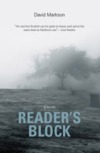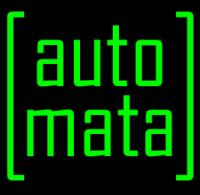Developers of digital storytelling systems, take note: The call for papers for the Fifth International Conference on Interactive Digital Storytelling is now out. Conference to be held November 12-15, 2012 in Spain.
Purple Blurb is Shaped Like Canada
We have an amazing Spring 2012 Purple Blurb lineup, thanks to this academic year’s organizer, Amaranth Borsuk, and featuring two special events and readings by two leading Canadian poets who work in sound, concrete, and conceptual poetry. The Purple Blurb series is supported by the Angus N. MacDonald fund and MIT’s Program in Writing and Humanistic Studies. All events are at MIT and are free and open to the public.
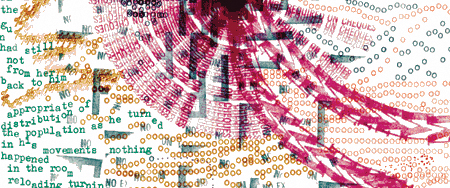
Monday, March 19
5:30 PM
6-120
Steve McCaffery
Author of Carnival, The Black Debt, Seven Pages Missing
Professor and David Gray Chair of Poetry and Letters, SUNY Buffalo
A central figure in Canadian avant-garde writing, Steve McCaffery’s work
spans sound poetry, generative and iterative text, experimental prose,
performance art, literary criticism, and visual poetics. A member of the
Four Horsemen sound poetry ensemble and a professor of English at SUNY
Buffalo, he is the author of over a dozen influential books of poetry,
twenty chapbooks and four volumes of critical writing. His works include
CARNIVAL panels 1 and 2, Panopticon, The Black Debt, North of Intention
and Rational Geomancy: Kids of the Book-Machine (with bpNichol). With Jed
Rasula, McCaffery edited Imagining Language, an anthology for MIT Press.
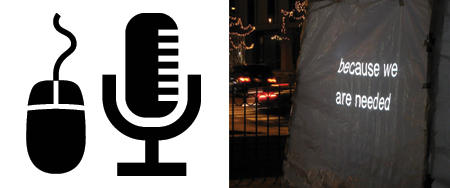
Monday, April 9
5:30 PM
6-120
Open Mouse / Open Mic
Featuring Alexandra Chasin, Ari Kalinowski, and YOU
Please join us for an open mic featuring D1G1T4L WR1T1NG for a variety of
platforms, from immersive projections by Ari Kalinowski to generative
fiction for the iPad by Alexandra Chasin.
Bring video art, interactive fiction, SMS poems, hypertext fiction and poetry, text generators, and any form of electronic literature you’ve got up your sleeve! This event is co-sponsored by the Electronic Literature Organization.
Alexandra Chasin is the author of Kissed By (FC2), and Selling Out: The Gay
and Lesbian Movement Goes to Market (St. Martin’s). She teaches Writing at
Lang College, The New School. Ari Kalinowski runs the Intermedia Poetry
Project.

Thursday, May 3
6:00 PM
6-120
Christian Bök
Professor of English, University of Calgary
Co-sponsored by the Visiting Artist Series and WHS
Author of Crystallography, Eunoia and The Xenotext.
Christian Bök is the author of Crystallography (Coach House Press, 1994),
nominated for the Gerald Lampert Award for Best Poetic Debut, and Eunoia, a
lipogram that uses only one vowel in each chapter, which won the 2002
Griffin Poetry Prize and is the best-selling Canadian poetry book of all
time. He is also author of Pataphysics: The Poetics of an Imaginary Science
(2001). His latest project, The Xenotext, encodes a poetic text into
bacterial DNA that will produce proteins in response—yielding another poetic
text. Bök has created artificial languages for Gene Roddenberry’s Earth:
Final Conflict and Peter Benchley’s Amazon.
1:00 PM – 7:00 PM
Bartos Theater
Friday, May 4
Unbound: Speculations on the Future of the Book
Co-sponsored by the Mellon Foundation, SHASS, WHS, the Arts at MIT Visiting
Artist Program, and the MIT Communications Forum
An afternoon of discussion with theorists and practitioners from MIT and
beyond who are concerned with the shape of books to come.
Participants include:
Christian Bök (University of Calgary)
Katherine Hayles (Duke University)
Bonnie Mak (University of Illinois at Urbana-Champaign)
Rita Raley (UC Santa Barbara)
James Reid-Cunningham (Boston Athenaeum)
Bob Stein (Institute for the Future of the Book)
E-Lit Platforms at the MLA
Dene Grigar, vice president of the Electronic Literature Organization and one of the organizers of the excellent e-lit gallery and reading here at the MLA Convention, just gave a great presentation about the importance of platform in the development and reception of electronic literature. I was pleased initially to see that there was not only this presentation with “Platform” in the title, then very interested to hear about her work in a lab with original older computer hardware and her discussion of platform differences and changes through the years.
Even more surprising is that Ian Bogost and I have managed to advance part of our diabolical plan to have people use five long, colored rectangles stacked on top of each other:

Brian Moriarty to Speak at MIT
In the Boston area? Please join us for a talk by
Brian Moriarty
Creator of Wishbringer, Trinity, Loom, and other interactive fiction and graphic adventure titles
and professor of practice, Worcester Polytechnic Institute
“Beyond Zork: Games & Interactive Fiction”
Monday, November 28, 5:30 pm
MIT’s room 6-120
Brian Moriarty built his first computer in the fifth grade. He began
publishing games in the early 1980s and in 1984 joined legendary text
adventure company Infocom, where he authored three award-winning interactive fiction titles, Wishbringer (1985), Trinity (1986) and Beyond Zork (1987). His first graphic adventure game, Loom, was published in 1990 by Lucasfilm Games to wide critical acclaim.
Sponsored by the Angus N. MacDonald Fund
As always, this Purple Blurb event is free and open to the public.
“Electrifying Literature” Deadline
An exhortation for those creating or researching electronic literature to please submit to Electrifying Literature: Affordances and Constraints, the 2012 Electronic Literature Organization conference. The gathering will take place June 20-23, 2012 in Morgantown, West Virginia. A juried Media Arts Gallery Exhibit will be held from Wednesday, June 13 through Saturday, June 23, 2012 at The Monongalia Arts Center. Registration costs have been kept down to make it easier for writers and artists who don’t have institutional travel support to be part of the event.
The deadline for abstracts & proposals is November 30, by the way.
Unconference/Hackday on Digital Writing
Normally I only mention events that I’m attending or organizing, but I want to announce this Boston-area event even though I’ll be in Chicago and won’t be able to attend.
It’s called Dangerous Readings, and is sponsored by Eastgate Systems. Check out the page to see how you can participate.
App of Leaves
Congrats to Andrew Plotkin (a.k.a. Zarf), interactive fiction author and active member of our local People’s Republic of Interactive Fiction, on the release of his first iPad app: My Secret Hideout. It’s not IF per se, but an interactive narrative toy – or, as Zarf says, “It’s an interactive toy… or rather poem… or artwork… It’s an interactive textual art generator set in a treehouse!” It has no score, possibly because life doesn’t work that way.
Check out Zarf’s page on My Secret Hideout for further details. Or, visit the App Store to nab it.
Another Note from Passo Fundo
Here’s another article about my talk today in Passo Fundo. It’s in Brazilian Portuguese, and has a less maniacal photo accompanying it than did the last article I mentioned. The Babelfish provides this translation into English.
Winter in Brazil, Southern Edition
Like my collaborator Noah Wardrip-Fruin, I have come to Brazil for the winter. But not to a nice warm part of Brazil — I’m in Passo Fundo, in the far South, at the 14th Jornada Nacional de Literatura. Here, it has been cold outside, but there has been great excitement about writing and literary art.

I have been correctly identified as a space man as I’ve shown and discussed interactive fiction, poetry generation, and other forms of electronic literature.
I gave a longer talk this morning about these topics, which was translated into Brazilian Portuguese as I spoke. Tomorrow, I will speak on a panel in the main tent to about 5000 people about certain types of “convergence” in writing and literature. The type I will address is a convergence between authors – collaboration.
NAFTA Party
A collaborative story by Jesse Ashcraft-Johnson, Eleanor Crummé, Alex Ghaben, Cisco Gonzales, Ray Gonzalez, Boling Jiang, Nick Montfort, Shannon Moran, Kirsten Paredes, Carter Rice, Tyler Wagner, and Jia Zhu
“Mr. President, can you summarize the events of the G-6 conference?”
“First, a bunch of world leaders surrendered their favorite prostitutes. Then, we all yelled ‘Yeehaw!'” That was what George H. W. Bush thought, anyway, as he delivered a quick straight answer to the question.
“Mr. President, what was your holiday message to the troops?”
“I told the boys: either step up to the challenge or there will be no Christmas presents this year.”
When the photo-op smiles fell away, there was a moment of hesitation between Bush, Canadian Prime Minister Mulroney and Mexican President Salinas. The prepared statements about NAFTA were left on the podium, the talking points and teleprompters left in the press room with the reporters. Music swelled outside closed doors. “Well — either we dance or we lose ourselves in emerging global markets!” Bush blurted out, the twang in his voice inviting them to the hoedown.
Whiskey heavy on his breath, Bush turned to Salinas and elbowed him playfully. “Were you tutoring someone last night in long division? Either that was a very short 18-year-old or you might want to go see a priest. I hear they’re good with that sort of thing.”
He felt Mulroney’s eyes on him and turned abruptly. “Do you have a staring problem, boy? You’re looking at me like a damn homosexual. Either you face me like a man or spend the night. I’ll pound you ’till you’re tender.”
Mulroney flashed a smile, then started. A SWAT team was scaling the White House wall. “Look!” he said, gripping President Bush’s hand. “Either monkeys are flying out of your butt, or we should really rethink what we told the police last night. Maybe that anonymous call to the FBI tip line about hiding little boys in the attic wasn’t such a great idea.”
As their hands touched, Bush remembered the secret NAFTA initiation ceremony of the previous night.
Salinas had been pouring shots of tequila for a while. Stumbling up on top of the table, Bush called for attention and announced: “In order to promote unity, we must remove all barriers to our freedom. That includes our clothing.” Salinas nodded gravely, adding, “we must be pure and unfettered in body as well as soul.” There were noises of confusion from the others gathered there. “Hey, I’m from Texas, bitches. This is how we roll. Go big or go home!” Mulroney reached deep into his pants and pulled out a 12-ounce bottle of maple syrup. “Big enough for you, Bush?” he shouted as he chugged it down with a giant sucking sound.
One thing led to another. In the darkness, having slipped past the Secret Service, they ended up joining hands while riding bicycles naked down Pennsylvania Avenue.
Bush was snapped out of his reverie by the arrival of the NAFTA treasurer who had come to brief the world leaders, who were inebriated once again, on the state of the budget.
“First, take off your clothes,” Bush told him. “Then we’ll talk … ”
An Amazing Linked List
I strongly encourage those of you who haven’t seen it yet to check out Brian Kim Stefans’s Introduction to Electronic Literature: a freeware guide.
Right now it is “just” a list of links to online resources, from Futurism through 2010, that are relevant to understanding different important aspects of electronic literature – making it, reading it, sorting through different genres, and understanding its historical connects.
It’s extremely useful in this form, but Stefans is also hoping to put these selections together in a Lulu.com book that he’ll sell at cost. To that end, he’s selected only texts – work that will fit in a book – as opposed to pieces that need to be read on a networked computer. Stefans also intends to put together a website that collects and mirrors these writings, uniformly typeset in a legible way, as PDFs.
I’m of course pleased that Stefans was inspired by The New Media Reader, which Noah Wardrip-Fruin and I edited for the MIT Press, and that he included a few of my pieces.
As I have a strong preference for assigning publicly available texts instead of scanned articles that live being a university paywall, I find these texts very useful for teaching. Stefans is taking suggestions for how to revise his Introduction over on his netpoetic.com post.
My Curveship Talk at PAX-East 2011
I gave a talk about Curveship in the “IF Suite” (actually an ordinary hotel room with a few upturned beds, not a suite) at PAX-East 2011 earlier this month. It was great to present to fellow IF author/programmers from around the world at this event, which was effectively the second annual Festival of Interactive Fiction. The IF Summit was organized by Andrew Plotkin, a.k.a. Zarf, once again this year. Thanks to Jason McIntosh, there’s pretty good-quality video (very good, considering the ramshackle setup) of the first 22.5 minutes of my talk:
The parts where I actually demo the system and discuss how games are written are missing, unfortunately, but my comments do introduce Curveship and its motivation.
Also check out the video documentation of the “Setting as Character” panel with Andrew Plotkin, Rob Wheeler, Stephen Granade, and Dean Tate. (This one took place in the more capacious Alcott Room, which we had on Saturday, March 12 thanks to Dave Cornelson.) Also, there’s video of the panel on “Non-Gamers Gaming,” with Caleb Garner, Tim Crosby, Heather Albano, Sarah Morayati, and Andrew Plotkin.
La Muchacha y el Lobo


In 2001, Beehive was the first Web publication to print a creative digital media piece of mine, “The Girl and the Wolf.” I had written this story back in 1997 in Janet Murray’s Interactive Narrative class at MIT. (These days, I teach this class here at MIT.) It was strongly inspired by the readings of folk tales we had done in Henry Jenkins’s Children’s Literature class. “The Girl and the Wolf” is a very early creative piece of mine, but I remain pleased with the systematic concept and with what I wrote. It’s a simple arrangement of nine versions of a story, allowing the levels of sex and violence to be increased independently. With some contemporary references and a few other turns of phrase, I introduced only a few deviations from well-known folkloric versions of the Little Red Riding Hood story.
Ruber Eaglenest has now translated this “variable tale” into Spanish as “La Muchacha y el Lobo.”
Eaglenest describes himself as a “wannabe” game programmer, but has participated in the Spanish IF community in many ways using the name El Clérigo Urbatain. In addition to writing many reviews and articles and doing several interviews, he has written and collaborated on several pieces of interactive fiction: Por la necedad humana, Astral, Aventurero en el Sega Park, El extraño caso de Randolph Dwight, and an episode of El museo de consciencias. He has also adapted several interactive fiction games and translated several to Spanish – most recently, Graham Nelson’s Relics of Tolti-Aph.
Eaglenest has also provided a lengthy and very useful post about the Little Red Riding Hood story and “The Girl and the Wolf” on his blog (in Spanish).
The IF Theory Reader Arrives
Almost a decade after the project began, the IF Theory Reader is finally here, thanks to the hard work of editors Kevin Jackson-Mead and J. Robinson Wheeler. The book has been published by Transcript On Press and has made it out in time for PAX-East, where Kevin’s group The People’s Republic of Interactive Fiction will be hosting a hospitality suite.
There are 438 pages in this book, which can be downloaded as a PDF for free or purchased as a paperback for a mere $13.26.
My own contribution, “Toward a Theory of Interactive Fiction,” has a first page which (except for the title of the article) is entirely occupied by a footnote. Perhaps ominously. I did, however, revise the article for the N+1th time, trying to make it a bit more accessible. I began writing this particular piece back when this book project was first being formulated, and am very, very glad to have it officially published after all these years.
The compendium of writing about interactive fiction that we finally have here includes 26 articles – the same number, I should mention, as there are letters of the alphabet:
- Crimes Against Mimesis – Roger S. G. Sorolla
- Toward a Theory of Interactive Fiction – Nick Montfort
- Characterizing, If Not Defining, Interactive Fiction – Andrew Plotkin
- not that you may remember time: Interactive Fiction, Stream-of-
- Consciousness Writing, and Free Will – Mark Silcox
- 2 Brief Dada Angels – Ryan Stevens, writing as Rybread Celsius
- Object Relations – Graham Nelson
- IF as Argument – Duncan Stevens
- The Success of Genre in Interactive Fiction – Neil Yorke-Smith
- Parser at the Threshold: Lovecraftian Horror in Interactive Fiction – Michael Gentry
- Distinguishing Between Game Design and Analysis: One View – Gareth Rees
- Natural Language, Semantic Analysis, and Interactive Fiction – Graham Nelson
- Afterword: Five Years Later – Graham Nelson
- Challenges of a Broad Geography – Emily Short
- Thinking Into the Box: On the Use and Deployment of Puzzles – Jon Ingold
- PC Personality and Motivations – Duncan Stevens
- Landscape and Character in IF – Paul O’Brian
- Hint Development for IF – Lucian Smith
- Descriptions Constructed – Stephen Granade
- Mapping the Tale: Scene Description in IF – J. Robinson Wheeler
- Repetition of Text in Interactive Fiction – Jason Dyer
- NPC Dialogue Writing – Robb Sherwin
- NPC Conversation Systems – Emily Short
- 10 Years of IF: 1994–2004 – Duncan Stevens
- The Evolution of Short Works: From Sprawling Cave Crawls to Tiny Experiments – Stephen Granade
- History of Italian IF – Francesco Cordella
- Racontons une histoire ensemble: History and Characteristics of French IF – Hugo Labrande
Again, congratulations to Kevin and Rob, and thanks to my fellow authors. I’ve read many of these articles before; I’m looking forward to sitting down and reading everything, previously seen and unseen, in this excellent codex.
Reader’s Block
A pivotal point in this book – one that is reassuringly labeled “A Novel” – is the paragraph that reads, in its entirety, “Spent Adidas.” The other shoe drops. Imagination finally spills from one isolated paragraph to the next. This two-word paragraph does not stand out as unusually short among many that relating incidents or facts; literary, artistic, or philosophical deaths; and sometimes simply an author’s or some famous character’s name. How can we avoid being overwhelmed by the weight of what we know, what we have read about other lives? How can what we have learned about history frame, rather than imprison, what we seek to create as readers and writers? Why even attempt to imagine, when truth is stranger and so weighty? These questions raise themselves like ghosts in Hades scenting blood. As in Wittgenstein’s Mistress, a powerful image of a writer’s path of thought. Then, the poesies that succeeded in Borges’s “The Circular Ruins” takes a different turn in Reader’s Block, after a struggle.
Label This One a Failure
It’s tough to write about the ideas that didn’t work out. Sometimes the negative results actually aren’t very interesting, and it’s better not to discuss them. In other cases, it’s impolite to point out other people’s roles – to blame them – and impossible to discuss the failure otherwise. But when a failure is not too big of a deal, possibly instructive to bring up, and as least as much my fault as anyone else’s, that rare opportunity to post about it presents itself.
In 2005, those of us blogging at Grand Text Auto had the idea of starting a “label.” We wanted something that would riff on our blog’s name and serve to showcase larger-scale projects that we did. The idea was that our creative projects would benefit from being associated with each other, just as our blog writing was more lively and had wider reach thanks to the shared context of Grand Text Auto.
After going through our usual best practices process of name development – perhaps, based on experiences like these, I’ll one day start a naming firm – we chose to call the label [auto mata]. With the square brackets and everything, if you want to really give a shout-out, although “Auto Mata” could work if that’s what fits your house style.
I offered to design the logotype. Now, I’m much less likely to start a career in graphic design, and certainly couldn’t drive that auto very far if I did, but I do like to indulge my dilettantish design interests when the opportunity presents itself. This is what I came up with:
Admittedly, it doesn’t exactly slap one in the face.
I don’t think my understated logo was the real problem with [auto mata], though. First Michael Mateas and Andrew Stern’s Façade (July 2005) and then my own Book and Volume (November 2005) were released “under” (perhaps “with” is a better preposition) this label. And that was it. No other “extraordinary e-lit, digital art, and computer games” appeared as [auto mata] releases, which was one big problem. A list of two things isn’t doing that much helpful association or offering people very much to browse. I think if we had kept adding a piece to the [auto mata] catalog every few months, we’d have accumulated a very interesting collection that people would be looking at. We might even encourage the crossing of boundaries between (the stereotypes of) literary work, visual art, and computer games that Grand Text Auto was all about. But we weren’t all regularly doing larger-scale projects that were downloadable. [auto mata] couldn’t really, in any straightforward way, “release” an immense, functional Atari VCS joystick.
Another problem, though, is that [auto mata] was just a list on a Web page. We didn’t build much buzz around [auto mata] itself, or work to promote the label per se as opposed to the two pieces that were released under it. Perhaps this work would have done itself to some extent as our list of publications grew and our offerings drew in people from different communities. But, unfortunately, the work wasn’t done.
Michael, Andrew, and I often mentioned [auto mata] in promoting our pieces. The site is still up. But now it’s 2011, and it’s worth noting that both Façade and Book and Volume have been published again in the fine context of the Electronic Literature Collection, volume 2. Although some “previous publication” information is included for each piece in the Collection, Michael, Andrew, and I all neglected to tell the editors that these two pieces are [auto mata] releases, so that information (provided within the pieces) doesn’t appear on the introduction pages where other bibliographic information is available.
Ah, well. I don’t regret the discussion that led to our developing [auto mata]; nor do I regret the not particularly onerous efforts that we took to get this label launched. In a different situation, such a label might have served not just to catalog work, but as an incentive or rallying point for the Grand Text Auto bloggers in creating work that could be proudly presented alongside other pieces. Perhaps a similar label could still do that for a different group of people.
Gatsby + NES … Abyss Gent?
If you’re a fan of the ideal (not the reality) of video games that are adapted from literary works, and particularly if you liked Gatz…
Do check out The Great Gatsby for NES. Old chap.




